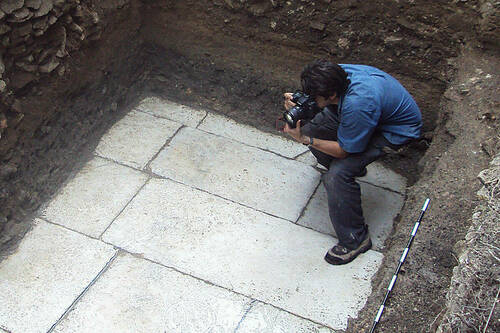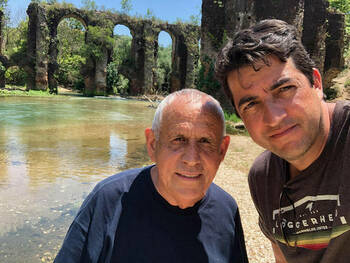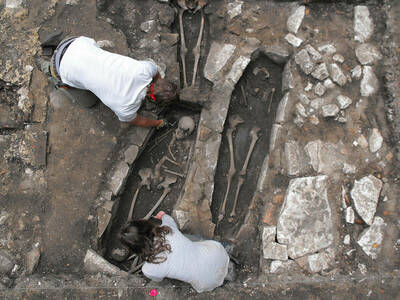
David Hernandez has found the archaeological equivalent to a time machine that takes him to the days when Jesus lived, Christianity emerged and Caesar Augustus ruled as the first Roman emperor.
Located in Albania between Greece and Italy, the Roman forum at Butrint has attracted Hernandez and others for nearly 20 years. Researchers grab pickaxes, shovels and a water pump to reveal a town plaza and emerging technologies of the time, which are well-preserved because they stayed submerged underwater for centuries.
Noteworthy finds at the UNESCO World Heritage site have included an aqueduct that supplied spring water from nearly four miles away and outdoor spaces made of limestone and marble. The excavating team has unearthed buildings that handled civil disputes and criminal complaints. Other structures served as houses of worship to the gods and Augustus. More buildings fostered business deals in the form of loans and buying shares of companies in the first version of the stock market.

The discoveries show the way of life during times presented in the Bible and the classics. They also present the greater context, Hernandez contends, for why Butrint is far more significant than scholars have previously recognized.
An associate professor and director of graduate studies in Notre Dame’s Department of Classics, Hernandez is now pouring his insight into a book about the Roman forum at Butrint. Supported by a Loeb Classical Library Foundation Fellowship at Harvard University, which he was awarded this spring, the book will further explore the relationship between the Romans and the Greeks by examining this understudied region.
“Butrint was a city at the northwest tip of Greece, closest to Italy, and rather than being marginal on the periphery, it played an important role in the creation of Roman Greece,” Hernandez said.
A profound experience
More than 2,000 years ago, Augustus ordered the build-out of the ancient Greek settlement of Butrint to serve as a practical and symbolic gesture of opportunity as a Roman colony in a new land — and the purported social and economic advancements that his empire could provide to the Greeks.
“Imagine an urban center paved entirely of gleaming white limestone with marble-veneered temples and public buildings in the Mediterranean summer — it was unbelievably brilliant. The sunlight reflected from it was an incredible force to contend with,” Hernandez said. “Augustus didn’t imbue the old cultural centers of Athens or Sparta in this way. He did this at Butrint to showcase Roman urbanism. It was a message of Roman imperialism.
“And the aim of the message was to co-opt the Greek elite into the Roman Empire and imperial system. It said to them, ‘If you cooperate and devote yourselves to the empire of Augustus, you too can be favored and experience these benefits.’”
Hernandez visited Butrint for the first time in 2003, and is now director of the Roman Forum Excavations Project, leading a team that includes scholars from Albania, Italy, the United Kingdom and elsewhere. The project is supported by Notre Dame Research and the Institute for Scholarship in the Liberal Arts. Hernandez has previously won fellowships from the Woodrow Wilson National Fellowship Foundation, American Council of Learned Societies, Butrint Foundation and American Philosophical Society.
In 2005, excavators discovered the forum that was the town square of the ancient city — it’s preserved incredibly well because earthquakes caused the land to fall below the water table and remain inaccessible for generations.
The excavating team uses a machine that can pump 2,000 liters of water per minute, leading to discoveries both big and small at the dig site. There are a number of statues of Augustus and the imperial family. Any buried, submerged wood is free of bacteria, so a plow from the third century B.C. looks like it was cut in the present day. Larger finds have included theaters, public buildings, temples and a basilica. An aqueduct allowed the forum to have public baths, pools and fountains.

“The impact of an aqueduct on urbanism is enormous because it brings an abundant flow of natural spring water, the highest-quality water even today,” Hernandez said. “Used for drinking, bathing and urban amenities, it raised the standard of living considerably.”
Public baths were the after-work place to go where people would mingle for hours in and around pools of varying temperatures, ending with a revitalizing cold plunge. The marble buildings created an environment for commerce and trade, and people gathered to buy and sell food, clothes, wine, olive oil, meat and fish. The basilica wasn’t a church, but instead served as a place for justice and business.
Once developed, the city was unlike anything seen before in northwest Greece — this was the first city in the region with a paved urban center; in this case, one made of ornate, high-quality limestone.
“People at the time saw a new city that was gleaming white — and this would have been a profound experience for them,” Hernandez said. “When we excavate a small portion of this pavement at site, we have to wear sunglasses because the gleam of reflected sunlight is very intense.”
A window into history
For Hernandez, history has always been a fascination. He studied physics as an undergraduate student at the University of California, Berkeley and was drawn to study the origins of the universe before ultimately pursuing a career path that mixes the classics with archaeology.

On an archaeological dig, adrenaline flows from the learning opportunities that never stop.
“Things like a simple pavement take on a whole new meaning when you think about what it meant to the people it was built for,” he said. “Things you take for granted in your own culture might become highly significant in another because of the importance they hold. It certainly expands your understanding of the human mind and how human beings think and the systems they create for themselves based on their own belief system.”
The effort also becomes personal when Hernandez and the team find burials at the site.
“There are few experiences on an excavation as poignant as discovering a burial, because they’re like time capsules,” he said. “And you know when you see a skeleton, there was a funeral that occurred 1,000 years ago, and it remained untouched, seemingly timeless, until you uncovered it. And you become part of that event.”
About 20 Notre Dame students have joined Hernandez on digs throughout the years, and he will keep coming back — his connection to the site supersedes anywhere else he has lived.
“There’s something magical about that process that leads to a very strong spiritual connection,” he said. “I never felt more closely bonded with an area, because of the amount of time, study and everything else that has gone into it.
“It’s a laboratory and a window into a small slice of history. We have no idea what we’re going to find when we dig it.”
Originally published by at al.nd.edu on April 13.